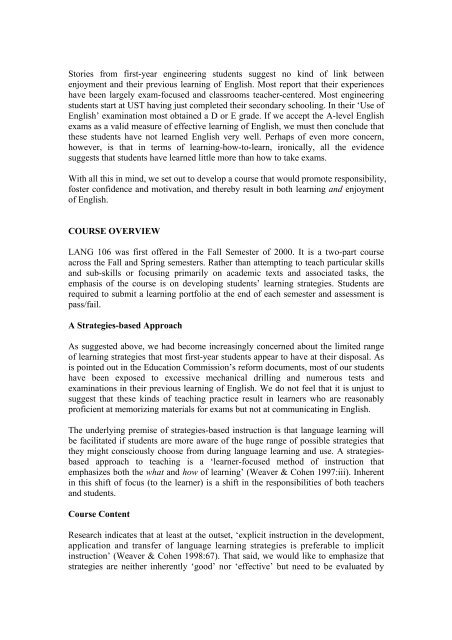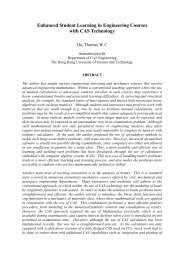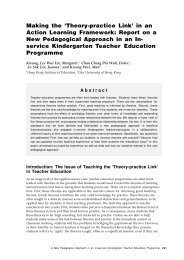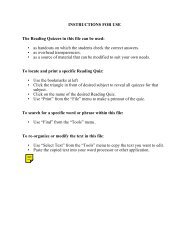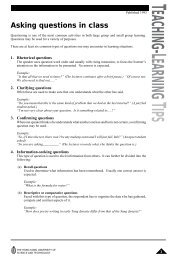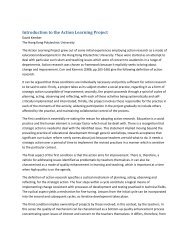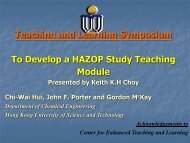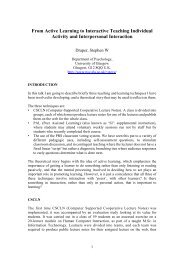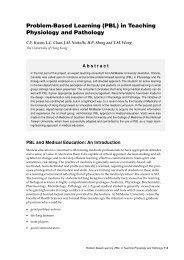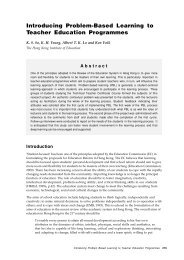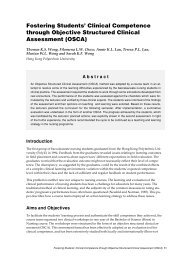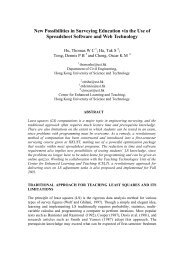The Education Commission's blueprint for the 21st century states that
The Education Commission's blueprint for the 21st century states that
The Education Commission's blueprint for the 21st century states that
You also want an ePaper? Increase the reach of your titles
YUMPU automatically turns print PDFs into web optimized ePapers that Google loves.
Stories from first-year engineering students suggest no kind of link betweenenjoyment and <strong>the</strong>ir previous learning of English. Most report <strong>that</strong> <strong>the</strong>ir experienceshave been largely exam-focused and classrooms teacher-centered. Most engineeringstudents start at UST having just completed <strong>the</strong>ir secondary schooling. In <strong>the</strong>ir ‘Use ofEnglish’ examination most obtained a D or E grade. If we accept <strong>the</strong> A-level Englishexams as a valid measure of effective learning of English, we must <strong>the</strong>n conclude <strong>that</strong><strong>the</strong>se students have not learned English very well. Perhaps of even more concern,however, is <strong>that</strong> in terms of learning-how-to-learn, ironically, all <strong>the</strong> evidencesuggests <strong>that</strong> students have learned little more than how to take exams.With all this in mind, we set out to develop a course <strong>that</strong> would promote responsibility,foster confidence and motivation, and <strong>the</strong>reby result in both learning and enjoymentof English.COURSE OVERVIEWLANG 106 was first offered in <strong>the</strong> Fall Semester of 2000. It is a two-part courseacross <strong>the</strong> Fall and Spring semesters. Ra<strong>the</strong>r than attempting to teach particular skillsand sub-skills or focusing primarily on academic texts and associated tasks, <strong>the</strong>emphasis of <strong>the</strong> course is on developing students’ learning strategies. Students arerequired to submit a learning portfolio at <strong>the</strong> end of each semester and assessment ispass/fail.A Strategies-based ApproachAs suggested above, we had become increasingly concerned about <strong>the</strong> limited rangeof learning strategies <strong>that</strong> most first-year students appear to have at <strong>the</strong>ir disposal. Asis pointed out in <strong>the</strong> <strong>Education</strong> Commission’s re<strong>for</strong>m documents, most of our studentshave been exposed to excessive mechanical drilling and numerous tests andexaminations in <strong>the</strong>ir previous learning of English. We do not feel <strong>that</strong> it is unjust tosuggest <strong>that</strong> <strong>the</strong>se kinds of teaching practice result in learners who are reasonablyproficient at memorizing materials <strong>for</strong> exams but not at communicating in English.<strong>The</strong> underlying premise of strategies-based instruction is <strong>that</strong> language learning willbe facilitated if students are more aware of <strong>the</strong> huge range of possible strategies <strong>that</strong><strong>the</strong>y might consciously choose from during language learning and use. A strategiesbasedapproach to teaching is a ‘learner-focused method of instruction <strong>that</strong>emphasizes both <strong>the</strong> what and how of learning’ (Weaver & Cohen 1997:iii). Inherentin this shift of focus (to <strong>the</strong> learner) is a shift in <strong>the</strong> responsibilities of both teachersand students.Course ContentResearch indicates <strong>that</strong> at least at <strong>the</strong> outset, ‘explicit instruction in <strong>the</strong> development,application and transfer of language learning strategies is preferable to implicitinstruction’ (Weaver & Cohen 1998:67). That said, we would like to emphasize <strong>that</strong>strategies are nei<strong>the</strong>r inherently ‘good’ nor ‘effective’ but need to be evaluated by


